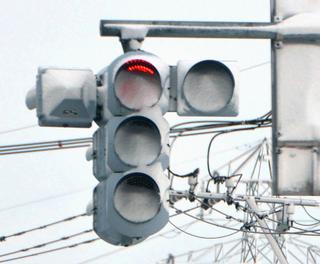Many governments and municipalities have taken to the installation of light-emitting diode (LED)-based street and traffic lights in their cities, towns, and villages as a means for saving energy and money.

One thing that’s not being considered is how the technology performs in adverse weather conditions; specifically, snow.
Case in point: Japan. The country states that about 45% of all of its stop-and-go signals use LEDs. But one of the benefits of the technology — low heat emission — has proven to be a bit of a hurdle during the winter months. You see, due to the fact that LEDs emit such little heat, when snow accumulates, the lamps fail to melt it away (studies by local police estimate the surface temperature of LED traffic signals vary between 20 and 29 degrees Celsius, while conventional lamps hover near the 45 degrees Celsius mark).
According to Akira Kudo of Aomori Prefectural Police, snow had to be manually removed from the lights between December and mid-February during blizzards, so that drivers could safely navigate their way through town.
“We don't have enough staff members to remove snow as more and more LED lights are being introduced,” he said.
This issue is not specific to Aomori only — in fact, police departments in 12 Prefectures are testing different fixes in hopes of finding one that will allow them to enjoy the benefits of the new technology, and not have to constantly tend to it. None have come up with a definitive solution yet, though there have been multiple attempts thus far.
Nippon Signal and Kyosan Electric Manufacturing have worked together to introduce a transparent, bowl-shaped cover to house the LED traffic signals and shield them from the snow. Prefectural police in Ishikawa have installed these covers on signals in 10 locations, but the change has not been all that noticeable. “They may be somewhat effective, but I saw snow piled up on the upper third of the cover,” said a sheet-metal worker living in the city of Hakusan.
Other manufacturers are experimenting with changing the shape of covers, applying special surface coatings and the like, but it’s still a lot of trial and error.
Another approach comes from Koito Electric Industries, based in the Shizuoka Prefecture. They developed a “flat” traffic signal that has the LEDs mounted on a plate about 6cm thick, and with the signal angled downward, rather than perpendicular to the road surface, to reduce direct exposure to snowfall.
Police in the Aumori Prefecture have installed a few of these signals and report improved visibility, but once the snow begins to stick, the colors become too concealed to see.
“There is no universal remedy because snow quality varies regionally,” said an official at Kyosan.
Police in the Yamagata Prefecture recently introduced a heated wire system to melt snow off traffic signals; specifically, they installed them on the red signals only. The solution worked up until the point of heavy snow. When the wire begins to become buried, it can no longer do its job as effectively, and the signal becomes hidden.
Police have asked the manufacturer to improve the system.
To remedy the situation, officials in the Aomori Prefecture have set up a group of research organizations in hopes of developing a solution to the new system.
“Developing a system that works is urgently needed to substitute for manual snow removal. If we succeed, we can expect demand nationwide,” said the group's chairman, Akira Kudo of the Aomori Prefectural Police.
Via: Nikkei
Advertisement
Learn more about Electronic Products Magazine





